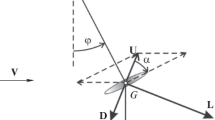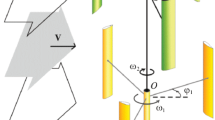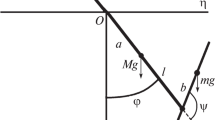Abstract
An autonomous nonconservative mechanical system with two degrees of freedom is studied. The system is subject to a feedback control with two control impact gain factors. It is required to select the values of these factors in such a way as to ensure existence of asynchronous self-sustained oscillations with prescribed properties. An iterative method is proposed to search for the corresponding values of control impact gain factors. This approach is based on constructing auxiliary second-order systems and generating limit cycles in these systems. The algorithm that is used for this purpose represents a modification of the Andronov–Pontryagin method, but does not require the presence of a small parameter in the system. The efficiency of this approach is illustrated on a problem of generating asynchronous self-sustained oscillations/rotations in a model of an aerodynamic pendulum. The applicability conditions of the algorithm and the possible modifications are discussed.
Similar content being viewed by others
REFERENCES
A. A. Andronov, “Les cycles limites de Poincaré et la théorie des oscillations auto-entretenues,” C. R. Seances Acad. Sci. 189, 559–561 (1929).
L. S. Pontryagin, “On dynamical systems close to Hamiltonian systems,” Zh. Eksp. Teor. Fiz. 4 (9), 883–885 (1934).
A. D. Morozov, Resonances, Cycles and Chaos in Quasi-Conservative Systems (Regular and Chaotic Dynamics, Izhevsk, Moscow, 2005) [in Russian].
S. A. Korolev and A. D. Morozov, “On periodic perturbations of self-oscillating pendulum equations,” Russ. J. Nonlinear Dyn. 6 (1), 79–89 (2010).
M. Bonnin, “Existence, number, and stability of limit cycles in weakly dissipative, strongly nonlinear oscillators,” Nonlinear Dyn. 62 (1-2), 321–332 (2010).
A. D. Morozov and O. S. Kostromina, “On periodic perturbations of asymmetric Duffing-van-der-Pol equation,” Int. J. Bifurcation Chaos 24 (5), 1450061 (2014).
L. Gavrilov and I. D. Iliev, “Perturbations of quadratic Hamiltonian two-saddle cycles,” Ann. Inst. Henri Poincare (C) Non Linear Anal. 32 (2), 307–324 (2015).
V. N. Tkhai, “Stabilizing the oscillations of a controlled mechanical system,” Autom. Remote Control 80 (11), 1996–2004 (2019).
L. A. Klimina, “Rotational modes of motion for an aerodynamic pendulum with a vertical rotation axis,” Moscow Univ. Mech. Bull. 64 (5), 126–129 (2009).
L. A. Klimina and B. Ya. Lokshin, “On a constructive method of search for rotary and oscillatory modes in autonomous dynamical systems,” Russ. J. Nonlinear Dyn. 13 (1), 25–40 (2017).
L. A. Klimina, B. Y. Lokshin, and V. A. Samsonov, “Bifurcation diagram of the self-sustained oscillation modes for a system with dynamic symmetry,” J. Appl. Math. Mech. 81 (6), 442–449 (2017).
A. D. Morozov and E. L. Fedorov, “On the investigation of equations with one degree of freedom, close to nonlinear integrable ones,” Differ. Uravn. 19 (9), 1511–1516 (1983).
I. A. Khovanskaya (Pushkar’), “Weak infinitesimal Hilbert’s 16th problem,” Proc. Steklov Inst. Math. 254 (1), 201–230 (2006).
A. M. Samoilenko, “Numerical analytical method of investigating periodic systems of ordinary differential equations. I,” Ukr. Mat. Zh. 17 (4), 82–93 (1965).
M. I. Rontó, A. M. Samoilenko, and S. I. Trofimchuk, “The theory of the numerical-analytic method: achievements and new trends of development. IV,” Ukr. Math. J. 50 (12), 1888–1907 (1998).
L. A. Klimina, “Method for finding periodic trajectories of centrally symmetric dynamical systems on the plane,” Differ. Equations 55 (2), 159–168 (2019).
L. A. Klimina and Y. D. Selyutskiy, “Method to construct periodic solutions of controlled second-order dynamical systems,” J. Comput. Syst. Sci. Int. 58 (4), 503–514 (2019).
L. A. Klimina, “Method for constructing periodic solutions of a controlled dynamic system with a cylindrical phase space,” J. Comput. Syst. Sci. Int. 59 (2), 139–150 (2020).
F. Schilder, H. M. Osinga, and W. Vogt, “Continuation of quasi-periodic invariant tori,” SIAM J. Appl. Dyn. Syst. 4 (3), 459–488 (2005).
K. Kamiyama, M. Komuro, and T. Endo, “Bifurcation of quasi-periodic oscillations in mutually coupled hard-type oscillators: demonstration of unstable quasi-periodic orbits,” Int. J. Bifurcation Chaos 22 (6), 1230022 (2012).
J. Bush, M. Gameiro, S. Harker, H. Kokubu, K. Mischaikow, I. Obayashi, and P. Pilarczyk, “Combinatorial-topological framework for the analysis of global dynamics,” Chaos: Int. J. Nonlinear Sci. 22 (4), 047508 (2012).
K. Kamiyama, M. Komuro, and T. Endo, “Algorithms for obtaining a saddle torus between two attractors,” Int. J. Bifurcation Chaos 23 (9), 1330032 (2013).
B. Zhou, F. Thouverez, and D. Lenoir, “A variable-coefficient harmonic balance method for the prediction of quasi-periodic response in nonlinear systems,” Mech. Syst. Signal Proc. 64, 233–244 (2015).
G. Chen and J. F. Dunne, “A fast continuation scheme for accurate tracing of nonlinear oscillator frequency response functions,” J. Sound Vib. 385, 284–299 (2016).
I. N. Barabanov and V. N. Tkhai, “Designing a stable cycle in weakly coupled identical systems,” Autom. Remote Control 78 (2), 217–223 (2017).
L. A. Klimina, “Method for constructing self-sustained rotations of a controlled mechanical system with two degrees of freedom,” J. Comput. Syst. Sci. Int. 59 (6), 817–827 (2020).
L. A. Klimina, A. A. Masterova, V. A. Samsonov, and Y. D. Selyutskiy, “ Numerical–Analytical method for searching for the autorotations of a mechanical system with two rotational degrees of freedom,” Mech. Solids 56 (3), 392–403 (2021) (in press).
S. A. Campbell, I. Ncube, and J. Wu, “Multistability and stable asynchronous periodic oscillations in a multiple-delayed neural system,” Phys. D: Nonlinear Phenom. 214 (2), 101–119 (2006).
A. S. Kosmodamianskii, V. I. Vorobiev, and A. A. Pugachev, “The temperature effect on the performance of a traction asynchronous motor,” Russ. Electr. Eng. 82 (8), 445–448 (2011).
A. A. Grin’ and S. V. Rudevich, “Dulac-Cherkas test for determining the exact number of limit cycles of autonomous systems on the cylinder,” Differ. Equations 55 (3), 319–327 (2019).
A. A. Grin’, “Transversal curves for finding the exact number of limit cycles,” Differ. Equations 56 (4), 415–425 (2020).
Z. D. Georgiev, I. M. Uzunov, and T. G. Todorov, “Analysis and synthesis of oscillator systems described by a perturbed double-well duffing equation,” Nonlinear Dyn. 94 (1), 57–85 (2018).
A. A. Andronov, E. A. Leontovich, I. I. Gordon, and A. G. Maier, Theory of Dynamic System Bifurcations on a Plane (Nauka, Moscow, 1967) [in Russian].
A. M. Formalskii, Stabilization and Motion Control of Unstable Objects (Walter de Gruyter, Berlin, Boston, 2015).
L. A. Klimina and A. M. Formalskii, “Three-link mechanism as a model of a person on a swing,” J. Comput. Syst. Sci. Int. 59 (5), 728–744 (2020).
A. Y. Aleksandrov and A. A. Tikhonov, “Averaging technique in the problem of Lorentz attitude stabilization of an earth-pointing satellite,” Aerospace Sci. Technol. 104, 105963 (2020).
V. I. Kalenova and V. M. Morozov, “Novel approach to attitude stabilization of satellite using geomagnetic Lorentz forces,” Aerospace Sci. Technol. 106, 106105 (2020).
P. Ashwin and O. Burylko, “Weak chimeras in minimal networks of coupled phase oscillators,” Chaos: Interdiscip. J. Nonlinear Sci. 25 (1), 013106 (2015).
Y. D. Selyutskiy, A. P. Holub, and M. Z. Dosaev, “Elastically mounted double aerodynamic pendulum,” Int. J. Struct. Stab. Dyn. 19 (5), 1941007-1–1941007-13 (2019). https://doi.org/10.1142/S0219455419410074
B. Ya. Lokshin, V. A. Privalov, and V. A. Samsonov, Introduction to the Problem of a Body Moving in a Resistant Medium (MSU, Moscow, 1986) [in Russian].
B. Y. Lokshin and V. A. Samsonov, “The self-induced rotational and oscillatory motions of an aerodynamic pendulum,” J. Appl. Math. Mech. 77 (4), 360–368 (2013).
V. A. Samsonov and Y. D. Seliutski, “Phenomenological model of interaction of a plate with a flow,” J. Math. Sci. 146 (3), 5826–5839 (2007).
L. Borkowski, P. Perlikowski, T. Kapitaniak, and A. Stefanski, “Experimental observation of three-frequency quasiperiodic solution in a ring of unidirectionally coupled oscillators,” Phys. Rev. E 91 (6), 062906 (2015).
A. D. Bruno, Local Method of Nonlinear Analysis of Differential Equations (Springer-Verlag, Berlin, Heidelberg, 1989).
A. D. Bruno, Power Geometry in Algebraic and Differential Equations (Elsevier, Amsterdam, 2000).
Funding
The study is supported by the Interdisciplinary Scientific and Educational School of Moscow University “Mathematical Methods of Complex Systems’ Analysis.”
Author information
Authors and Affiliations
Corresponding author
Additional information
Translated by E. Oborin
About this article
Cite this article
Klimina, L.A. Method for Generating Asynchronous Self-Sustained Oscillations of a Mechanical System with Two Degrees of Freedom. Mech. Solids 56, 1167–1180 (2021). https://doi.org/10.3103/S0025654421070141
Received:
Revised:
Accepted:
Published:
Issue Date:
DOI: https://doi.org/10.3103/S0025654421070141




